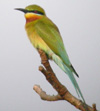
Real Birder
 |
Real Birder |
||||
| |
Fuerteventura - February 2007 |
|
This report is in actual fact, a summary of three seperate visits that I made to the island of Fuerteventura. The periods covered were as follows:- 16th to 22nd November 2005
4th to 18th October 2006
7th to 21st February 2007
My primary aim was to find the Houbara Bustard Chlamydotis undulata fuertaventurae. Secondly I hoped to see such birds as the Fuerteventura Chat Saxicola dacotiae, previously know as the Canary Island Chat, but since it can only be found on Fuerteventura it was felt that it's name should reflect the fact. For those who are not aware of the geography of the island, let me enlighten you somewhat. The Canary Islands can be split roughly into two separate groups. The western islands, comprising: Gran Canaria, Tenerife, La Gomera, La Palma and El Hiero. The island is the second largest of the whole group being 1,731 sq kms. It is 100 kilometres from the coast of southern Morocco and shows certain botanical and zoological similarities to that country. Fuerteventura is home to some desert species of birds, including Houbara Bustard, Cream-coloured Courser, Black-bellied Sandgrouse, Trumpeter Finch and Egyptian Vulture. Other endemic birds are Berthelot's Pipit, Plain Swift, Pallid Swift, Stone Curlew and Lesser Short-toed Lark. All the birds mentioned above are endemics of one sort or another; some to Fuerteventura alone or to the Canary Islands as a group or as Macaronesia endemics. Even the Yellow-legged Gull Larus cachinnans atlantis is an endemic being confined to the Macaronesian area. Macaronesia consists of five groups of islands as follows: Azores, Madeira, the Salvage Islands, the Canary Islands and the Cape Verde Islands.
At the end of the report I have taken the liberty of listing all the birds that I saw on all three trips. This is because the population of birds can change dramatically with the seasons so that what was there yesterday may not be there tomorrow; it depends on migration. For example, when I was there during October I saw numbers of various flycatchers, but in February there were none to be seen. By the same token, in October there were no American ducks, but in February there were such 'gems' as Blue-winged Teal, Lesser Scaup and Ring-necked Duck. TRANSPORT & ACCOMMODATION
I would advise that you take stout footwear because some of the going is quite rough and walking over lava fields can be hard on your shoes. Never leave your car without water even if you only mean to go a short distance. In February 2007 the temperature peaked at around 33 degrees in mid-afternoon; so be warned. I would also advise wearing a hat. Remember this island is an extension of the Western Sahara.
Another publication which may be of use to you is the Gostours guide to Finding Birds in the Canary Islands by Dave Gosney. Between that publication and the Clark and Collins one mentioned above, you should be able to find most of the best spots, but please do explore - you can never tell what you may find. Species List & distribution details Fuerteventura Update December 2009
Frances Gatens |
| ©2012 Real Birder | Home • Photos • Trip Reports• Links • Contact Us |